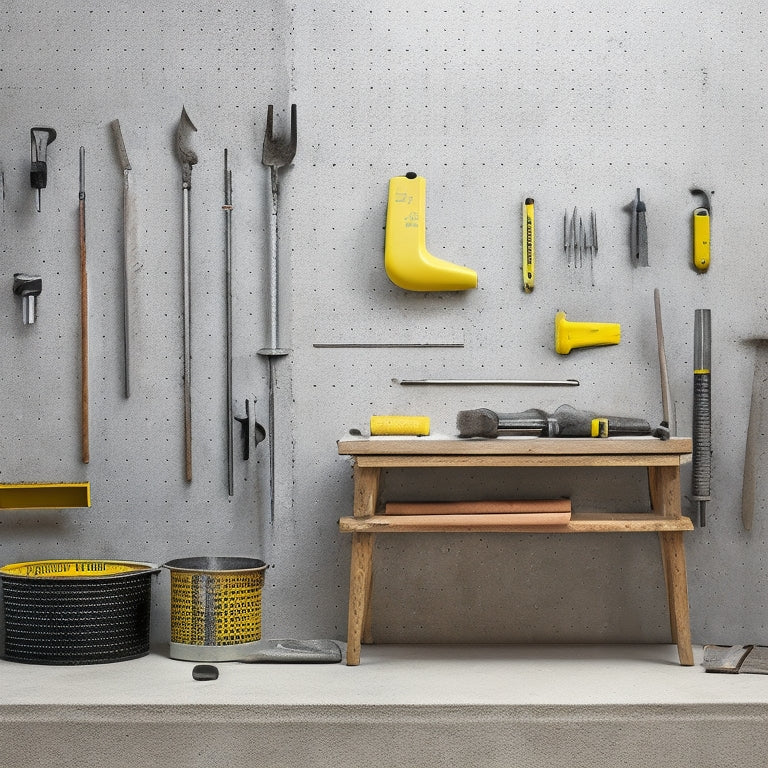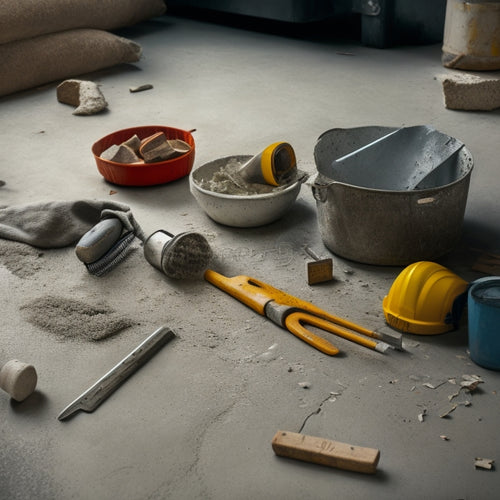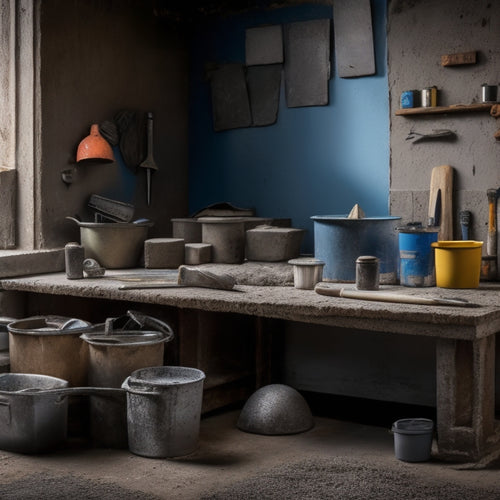
10 Must-Have Tools for Concrete Repair Organization
Share
You'll need a solid organization system to keep your concrete repair tools and materials within easy reach, protected from damage, and ready for use when you need them. Start by allocating dedicated storage for crack sealing equipment, and organize your tools into groups like application tools, cleaning tools, and sealant materials. Invest in a sealant applicator organizer system, epoxy injection kit organizer, and a tool cart for easy mobility. Don't forget essential cleaning supplies, a concrete mixing bucket, and safety gear like respiratory protection and eye protection solutions. As you set up your system, you'll identify what else you need to optimize your workflow.
Key Takeaways
- Organize crack sealing equipment into application tools, cleaning tools, and sealant materials to prevent damage and loss.
- Use labeled bins, containers, or shelves to store tools, ensuring quick location and reducing search time.
- Store melter and applicator separately from cleaning supplies to avoid cross-contamination and maintain quality.
- Invest in a sealant applicator organizer system with tool-specific compartments for easy access and customization.
- Keep epoxy resin and hardener in airtight containers to prevent contamination and degradation in epoxy injection kits.
Crack Filling Tool Storage Ideas
Five essential crack filling tools typically occupy a contractor's workspace, and each requires dedicated storage to prevent damage, loss, or misplacement.
You'll need to allocate specific storage space for your crack sealing equipment to guarantee it remains organized, accessible, and protected from the elements.
Optimize your storage space by categorizing your tools into groups, such as application tools, cleaning tools, and sealant materials.
Assign a designated area for each group, and consider using labeled bins, containers, or shelves to keep similar items together. This will help you quickly locate the tools you need when implementing different crack sealing techniques.
For instance, store your melter and applicator in a separate area from your cleaning supplies to prevent cross-contamination.
Likewise, keep your sealant materials in a dry, temperature-controlled environment to maintain their quality.
Essential Cleaning Supplies Checklist
Organize your cleaning supplies by compiling a checklist of vital items to confirm you're well-prepared for concrete repair projects.
Effective cleaning techniques are important for successful surface preparation, and having the right tools guarantees a smooth repair process.
Here is your essential cleaning supplies checklist:
-
Power washer: A high-pressure washer is necessary for removing dirt, grime, and old coatings from the concrete surface.
-
Brooms and scrub brushes: These are essential for sweeping away debris and scrubbing stubborn stains.
-
Cleaning solutions: Keep a stock of degreasers, detergents, and acidic cleaners to tackle various types of stains and contaminants.
- Microfiber cloths and rags: These are perfect for wiping down surfaces, absorbing spills, and cleaning tools.
With these essential cleaning supplies, you'll be able to employ effective cleaning techniques, confirm proper surface preparation, and set your concrete repair project up for success.
Sealant Applicator Organizer Systems
You'll appreciate the benefits of a sealant applicator organizer system that provides easy access storage, allowing you to quickly grab the tools you need.
A well-designed system should also feature tool-specific compartments that keep your applicators, nozzles, and other accessories organized and protected.
Additionally, look for systems with adjustable organizer panels that can be customized to fit your specific toolset.
Easy Access Storage
During concrete repair projects, having the right sealants and applicators within easy reach can greatly enhance productivity.
Easy access storage solutions, such as sealant applicator organizer systems, help you stay organized and focused on the task at hand.
To maximize your storage space, consider the following strategies:
-
Categorize tools by function: Group similar tools, such as sealant guns and nozzles, together to reduce search time.
-
Assign a home for each tool: Designate a specific spot for each item, making it easy to find what you need when you need it.
-
Utilize vertical shelf organization: Make the most of your storage space by using stacked shelves or wall-mounted racks.
- Label and sign storage areas: Clearly identify what's stored in each area to avoid confusion and save time.
Tool Specific Compartments
Five essential compartments in a sealant applicator organizer system streamline your workflow: one for sealant guns, another for nozzles, a third for tips, a fourth for hoses, and a fifth for accessories. This compartmentalization guarantees that every tool has its designated place, making it easier to find what you need when you need it.
With tool-specific compartments, you can extend the life of your sealant applicator tools. For instance, storing nozzles in a separate compartment protects them from damage and prevents clogging.
Similarly, keeping hoses in a dedicated compartment prevents kinking and tangling, which can reduce tool durability.
You can also customize the compartments to fit your specific needs. If you have a favorite sealant gun or nozzle, you can allocate a larger compartment for it.
This level of compartment customization guarantees that your tools are organized according to your workflow, making you more efficient on the job site.
Adjustable Organizer Panels
As you work on various concrete repair projects, it's essential to have an organizer system that adapts to your changing needs.
Adjustable organizer panels, also known as sealant applicator organizer systems, offer the flexibility and customization you need to stay organized and efficient. These panels can be customized to fit your specific tool requirements, allowing you to maximize your workspace and reduce clutter.
Here are some key benefits of adjustable organizer panels:
-
Panel customization options: Choose from a variety of panel sizes, shapes, and configurations to fit your unique needs.
-
Easy tool access: Store your tools in a logical and accessible manner, making it easy to grab what you need when you need it.
-
Organizing tips: Use dividers, bins, and other accessories to create separate compartments for different tools and materials.
- Space-saving design: Optimize your workspace by storing tools and materials in a compact, organized manner.
Tool Cart for Easy Mobility
You'll find that a tool cart is an essential component of your concrete repair arsenal, providing easy mobility and keeping all your necessary tools within arm's reach. This is especially important when working on large projects that require frequent movement between areas. A tool cart with ergonomic design features can markedly reduce fatigue and increase productivity.
When selecting a tool cart, consider the following key features:
| Feature | Description |
|---|---|
| Weight Capacity | The maximum weight the cart can hold, ensuring it can handle your tools and materials. |
| Storage Compartments | The number and size of compartments, which affect the cart's organizational capabilities. |
| Wheel Type | The type of wheels, such as rubber or polyurethane, which impact the cart's mobility on different surfaces. |
| Foldability | The ability to fold the cart, making it easier to store and transport. |
Concrete Mixing Bucket Essentials
With your tool cart stocked and ready to roll, it's time to focus on the heart of concrete repair: mixing and preparing the concrete itself.
A well-stocked mixing bucket is crucial to achieving the right consistency and performance of your concrete repair material.
When it comes to selecting the right mixing bucket, consider the following essential items:
-
Heavy-duty bucket material: Look for buckets made from durable materials like steel or high-density polyethylene (HDPE) that can withstand the rigors of mixing and handling heavy concrete.
-
Mixing paddles and drills: Invest in high-torque drills and heavy-duty mixing paddles designed for concrete mixing to guarantee efficient and thorough mixing.
-
Measuring cups and scoops: Include measuring cups and scoops to accurately measure and mix the correct proportions of concrete repair material.
- Bucket liners and cleaning tools: Don't forget bucket liners to prevent material buildup and cleaning tools like wire brushes and scrubbers to keep your bucket in good condition.
Curing Compound Application Tools
Curing compound application requires precision and control to guarantee a strong, durable bond between the repair material and the existing concrete. You need the right tools to guarantee accurate and efficient curing compound application.
| Tool | Description |
|---|---|
| Sprayers | For even distribution of curing compounds, sprayers are essential. They allow for adjustable spray patterns and flow rates, guaranteeing consistent coverage. |
| Laminated Brushes | These brushes provide a smooth, even application of curing compounds, reducing the risk of uneven distribution and guaranteeing a strong bond. |
| Microfiber Rags | Absorbent microfiber rags are perfect for applying and spreading curing compounds, allowing for a smooth, even finish. |
When selecting curing compound application tools, consider the specific curing techniques and application methods required for your project. For instance, sprayers are ideal for large areas, while laminated brushes are better suited for smaller, more detailed applications. By investing in the right tools, you'll guarantee a strong, durable bond between the repair material and the existing concrete, resulting in a successful concrete repair project.
Epoxy Injection Kit Organizer
The epoxy injection kit organizer is an essential tool for efficient and successful concrete repair projects, guaranteeing that all necessary materials are within easy reach and organized for quick access.
This tool allows you to streamline your epoxy application techniques, saving time and increasing productivity. By keeping all your materials organized, you can focus on the task at hand, assuring a high-quality repair that takes advantage of the many epoxy repair benefits.
Here are some key items to include in your epoxy injection kit organizer:
- Epoxy resin and hardener: Store these in airtight containers to prevent contamination and degradation.
- Injection ports and fittings: Organize these by size and type to guarantee you have the right ones for the job.
- Mixing sticks and gloves: Keep these clean and stored in a dry place to prevent damage.
- Instructional guides and data sheets: Keep these handy to reference epoxy application techniques, safety precautions, and product specifications.
Chisel and Hammer Storage Tips
You've organized your epoxy injection kit, now it's time to turn your attention to the chisels and hammers that help you prepare the concrete surface for repair. Proper storage of these tools guarantees they remain in good condition, easily accessible, and ready for the next job.
When storing chisels, consider the type of chisel and its intended use. For example, pointed chisels are best stored separately from flat chisels to prevent damage.
| Tool | Storage Tips |
|---|---|
| Chisels | Store in a dry place, away from direct sunlight. Organize by type (e.g., pointed, flat, etc.). |
| Hammers | Hang hammers with a hook or store in a designated area to prevent damage to the handle. |
| Hammer Materials | Store hammers made of different materials (e.g., fiberglass, steel, titanium) separately to prevent cross-contamination. |
| Chisel Sets | Store chisel sets in a protective case or pouch to prevent damage and rust. |
Remember to clean and dry your chisels and hammers before storing them to prevent rust and corrosion. By following these storage tips, you'll be able to maintain the quality of your tools and guarantee they're ready for the next concrete repair job.
Safety Gear for Concrete Work
When working with concrete, you'll be exposed to hazardous materials, dust, and debris, which is why it's essential to wear the right protective clothing essentials, such as gloves, long-sleeved shirts, and pants.
In addition, you'll need respiratory protection options, like dust masks or respirators, to prevent inhaling harmful particles.
Moreover, don't forget to prioritize eye protection solutions, including safety glasses or goggles, to shield your eyes from flying particles and chemicals.
Protective Clothing Essentials
Safety demands attention on the concrete repair site, where harsh chemicals, heavy machinery, and rough textures pose constant threats to your well-being. You need the right protective clothing to shield yourself from harm and guarantee a safe working environment.
To get started, you'll need:
- Protective gloves to prevent cuts, abrasions, and chemical exposure.
- Safety goggles to protect your eyes from flying debris and chemical splashes.
- High visibility vests to increase visibility in low-light conditions and busy work zones.
- Durable knee pads to reduce the impact of kneeling on hard surfaces.
Additionally, consider investing in hard hats, waterproof boots, and impact-resistant gear to safeguard your head, feet, and body from accidents.
Cooling bandanas and reflective clothing can also enhance your comfort and visibility on the job site.
Respiratory Protection Options
Three primary respiratory hazards in concrete repair are airborne silica, cement dust, and crystalline silica, all of which can cause serious health issues, including silicosis, lung cancer, and chronic obstructive pulmonary disease (COPD).
To protect yourself, you'll need reliable respiratory protection options.
You'll want to take into account different respiratory mask types, such as half-face or full-face masks, which filter out airborne particles. Look for masks with a HEPA (High Efficiency Particulate Air) filter, which captures 99.97% of particles as small as 0.3 microns. Some masks also come with an exhale valve to reduce moisture buildup.
In addition to masks, air filtration systems can provide an added layer of protection. These systems use a fan to draw in air, which is then filtered to remove particles and contaminants. They can be especially useful when working in confined spaces or areas with high levels of airborne silica.
When choosing a respiratory protection option, make certain it fits comfortably and is worn correctly to guarantee maximum protection.
Regularly maintain and replace filters to confirm their effectiveness. By taking these steps, you can greatly reduce your risk of respiratory hazards and protect your health.
Eye Protection Solutions
Protecting your eyes from concrete repair hazards is crucial, as flying debris, chemical splashes, and airborne particles can cause serious injuries, including corneal abrasions, chemical burns, and even permanent vision loss.
When it comes to eye protection, you have several options to choose from. Here are some must-haves for your concrete repair organization:
-
Safety Glasses: These are a staple for any concrete repair job. Look for glasses with scratch-resistant lenses, durable frames, and good optical clarity.
-
Face Shield: A face shield provides additional protection for your eyes and face from chemical splashes and flying debris. It's essential when working with harsh chemicals or power tools.
-
Goggles: Goggles offer a higher level of protection than safety glasses and are ideal for tasks that involve heavy dust or debris, such as sanding or grinding.
- Prescription Safety Glasses: If you wear prescription glasses, consider investing in prescription safety glasses that meet ANSI standards for impact resistance.
Portable Worklight for Dark Spaces
When working on concrete repairs in confined or dimly lit areas, a reliable portable worklight becomes an essential ally, illuminating the work zone and allowing you to focus on the task at hand.
A good portable worklight should provide sufficient LED brightness levels to light up the area, making it easier to identify cracks, damages, or other issues. Look for LED brightness levels ranging from 1,000 to 5,000 lumens, depending on the size of the area you need to illuminate.
Battery life considerations are also significant when selecting a portable worklight. You'll want a light that can last at least 8 hours on a single charge, ensuring you can complete your task without interruptions. Some worklights come with adjustable brightness settings, which can help conserve battery life.
Additionally, consider a worklight with a durable design, resistant to dust, water, and rough handling. A portable worklight with a magnetic base or hook can be especially useful, allowing you to position the light exactly where you need it.
Frequently Asked Questions
How Do I Prevent Tools From Getting Lost on a Large Job Site?
You prevent tools from getting lost on a large job site by implementing effective tool tracking and job site management systems, such as labeling tools, designating storage areas, and conducting regular inventory checks.
Can I Use a Pressure Washer for Cleaning Concrete Surfaces?
You can effectively use a pressure washer for cleaning concrete surfaces, leveraging its benefits like efficient dirt removal and surface preparation; however, you'll need to perfect concrete cleaning techniques, such as adjusting pressure and nozzle distance, to avoid surface damage.
What Is the Best Way to Organize Small Concrete Repair Accessories?
You visualize a clutter-free workspace, where every small concrete repair accessory has its designated spot. You achieve this by investing in a compact accessory storage system and taking the time to carefully label each tool, ensuring you can quickly locate what you need.
Are There Any Eco-Friendly Options for Concrete Repair Materials?
You're seeking eco-friendly options for concrete repair materials, and you'll find sustainable materials and biodegradable additives that reduce environmental impact, such as recycled aggregates, fly ash, and natural fibers, which can replace traditional cement and reduce carbon footprint.
Can I Use a Concrete Repair Tool Kit for DIY Projects at Home?
As you initiate DIY projects, you'll find that a concrete repair tool kit can be your trusted companion, enabling you to excel in various concrete repair techniques; with the right kit, you'll access expert-level DIY project tips to tackle cracks and imperfections like a pro.
Conclusion
With these 10 must-have tools, your concrete repair organization will be a well-oiled machine, churning out high-quality repairs like a factory on steroids! From crack filling to epoxy injection, you'll be equipped to tackle any job with ease and efficiency. With every tool at your fingertips, you'll be working like a pro in no time, leaving your competition in the dust.
Related Posts
-

Top 10 Concrete Repair Tools for Small Fixes
You'll need the right tools to tackle small concrete repairs efficiently and effectively. When it comes to small fixe...
-

Top Tools for Mixing Concrete at Home
When mixing concrete at home, you'll need a range of tools to guarantee a successful operation. Start with essential ...
-

Top Tools for Beginners in Concrete Masonry Coating
You're about to begin a concrete masonry coating project, and having the right tools is essential. Start with essenti...


